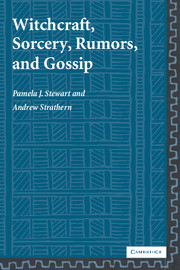2 - Rumor and Gossip: An Overview
Published online by Cambridge University Press: 20 November 2009
Summary
In the preceding chapter we have pointed out the crucial significance of rumor and gossip in community contexts that lead to accusations of witchcraft. It is a part of our overall argument that even when particular notions of witchcraft or sorcery are not involved, rumor and gossip themselves may act as a kind of witchcraft, projecting guilt on others in ways that may cause them harm: for example, to lose their jobs, to be physically attacked, or to be socially shamed. Because rumor and gossip work covertly, outside formal mechanisms for social control, they cannot easily be checked on or verified by explicit means. They can nevertheless produce results in themselves regardless of verification, as all political “spin” artists and propagandists know. Asked why a false rumor of wrongdoing by an opponent should be disseminated, the propagandist may advise his client that this will force the opponent publicly to deny the rumor, which may only increase people's suspicions that it is in some way accurate. Legal rules of libel and slander are developed to control the escalation of such attacks, just as rules are put in place to punish those found guilty of threatening hoaxes. Journalists may be threatened with lawsuits for defamation following their repetition of stories against public personalities, such as Dominick Dunne's story about the politician Gary Condit (see the New York Times, January 28, 2003, p. B1).
- Type
- Chapter
- Information
- Witchcraft, Sorcery, Rumors and Gossip , pp. 29 - 58Publisher: Cambridge University PressPrint publication year: 2003



